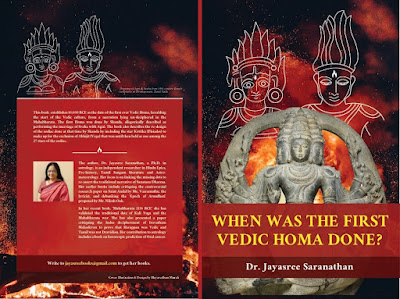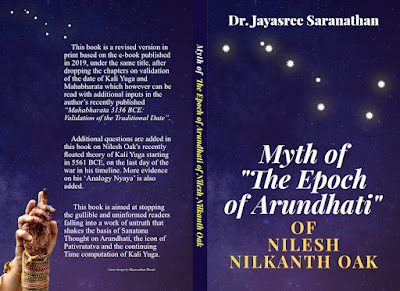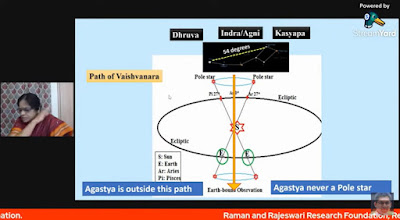From
Faith gets evidence from Science
by Sandhya Jain
(Earlier published in Panchjanya.com in Hindi )
The Archaeological
Survey of India (ASI) is set to undertake the first
scientific investigation of Rama Setu, the isthmus between India and Sri
Lanka that enabled Rama’s army to cross the ocean and reach Ravana’s kingdom to
rescue his wife. The Setu is a 48-km long chain of corals and shoals that
scholars believe is a natural formation that was augmented by human hand. The
ASI believes that studying this underwater formation will “help determine the age of the
Ramayana period.” The study will be undertaken by the CSIR-National
Institute of Oceanography (NIO), Goa, using radiometric and thermo luminescence
dating for geological timescale.
Prof. Sunil Kumar Singh,
director, NIO, said the three-year probe, to begin in March
2021, aims to determine if
Ram Setu is man-made and establish its age scientifically. The results
will be verified and co-related with information in Ramayana and other
scriptures. The age of the sediments will be determined via Carbon dating
techniques. Investigations will cover a range of scientific techniques such as
material composition, sub-surface structure, and excavation of remnants or
artifacts, if any, from the site. Underwater photography will help determine
any habitation remains in the area. Later, scientists will drill into the structure,
gather samples and undertake laboratory-based studies.
Prof Singh noted that some scriptures
mention wooden slabs along the Setu. If these
existed, they would have fossilised by now, and the team will search for them. As the sea bed around the Setu is shallow, barely three to
four metres deep, it should be easy to study the structure. This fact is
one of the major arguments against dredging the area to accommodate large
modern ships.
Dr Badrinarayanan, former
director, Geological Survey of India, stated in an interview (Rediff.com, July
31, 2007) that Ram Setu lay in a volcanic region with hot spots underneath; it
was constructed around 7000 years Before Present (BP). Asserting that the top portion “appears to be a
man-made structure”, he explained that it is originally a natural divide
separating the Bay of Bengal and Indian Ocean, so the geological
characteristics are different on either side.
During the Ice Age around 18,000 years
ago, the sea level was lower by 130 metres than at present, due to
de-glaciation. Around
7,300 years ago, major flooding caused the sea level to rise 4 metres higher
than what it is today. But the bund linking India and Sri Lanka is not a
mere sand dune.
The Geological Survey of India conducted
surveys for the Sethu Samudram Canal project authorities in 2004-05. On approaching the structure, they found a sudden rise in the
land level: from 10-12 metre it rose 1.5 metre. The northern side is the
turbulent Palk Bay that is prone to cyclones, and the tranquil southern side is
the Gulf of Mannar which is pristine. It hosts nearly 21 islands full of
corals. The GSI did some drilling at the deeper level of about 180-200 metres,
but seems not to have probed the top portion.
The National Institute of
Oceanography (NIOT) dug around 10 bore holes along the Adam’s
Bridge alignment; four were along the islands (where sands keep shifting) and
six in the water. It found that everywhere, below the
top six metres, there were marine sands on top and below a mix of corals,
calcareous sandstones, and boulder-like materials. Further below, up to 4-5 metres,
again there was loose sand and after that, hard formations.
This, according to Dr Badrinarayanan,
shows the structure is not
natural. Corals are found only on rocks and hard surfaces. But on the
Setu, below the corals and boulders, were loose sand, and on top of the loose
sand, formed when the sea level was low, divers found boulders, which normally
occur on land. The
boulders are not a marine formation. Somebody dumped the boulders to use the
structure as a causeway.
In Rameswaram, Pamban, Tuticorin region,
one can see old corals on the land, because the sea level was 4 metres higher
at the time they were formed 7,300 to 5,800 years ago. Then, from 5,800 to 5,400 years ago, the sea level
fell, and from 5,400 to 4,000 years ago, it rose 2 metres higher than it is
today. Hence, we find corals at two levels.
Between
5,800 to 5,400 years ago, or around 4,000 years ago, somebody brought all the
boulders to the Setu. All aerial pictures show the Setu as 2 to
3 km wide. It is high on the eastern side, so someone took advantage of the
raised portion and dumped the boulders to cross the waters. On the Rameswaram
islands and in Pamban, on both sides of the railway bridge, one can see such
formations and raised corals, which suggest that quarrying was done there.
Since no one will dump materials for 30 km, the task was undertaken to cross
the sea. The boulders are compact and light.
The region is geologically and
geo-tectonically sensitive. Drilling revealed hot springs of 60 to 70 degrees Celsius.
Earthquakes in Sri Lanka are felt in India, which means a major fault-line runs there. Towards the north and south, are remnants of old
volcanoes.
It seems obvious, therefore, that widening the water channel could activate the fault-line
and trigger seismic activity or earth quakes. It is well known that
cyclones or tsunamis in the Bay of Bengal are contained by the Setu, or they
would devastate southern India.
*
Tamil sources uphold the significance of
Ram Setu as national heritage. Scholar Jayasree
Saranathan observes that Valmiki Ramayana mentions a tsunami-impact at the isthmus just before Rama built the
Setu, and probably caused the submergence of
Southern Madurai around that time. Rama and the Vanaras reached the
shore (VR 6:4) and waited for three days to find an opening in the ocean,
failing which Rama shot an arrow to part the waters. After much tumult in the
waters, Sāgara (God of the Sea) appeared and promised to hold back the waters
so that the Vanaras could build the bridge, which they did in five days.
Saranathan
puts Ramayana events at the time when the old Tamil kingdom of Pandyans was
ruling in the South. Valmiki Ramayana mentions Kavatapuram, capital city of the Pandyas; there is
also a corroboratory reference to Ravana in the Sinnamanur
copper plates of the Pandyans. The copper plates mention that the
Pandyans often clashed with Ravana and made him seek truce, or negotiated with
him for some reason. This proves that Ravana was not a mythical character, and that Ramayana happened.
Saranathan estimates that per literary and epigraphic evidences, the Ramayana
period must have happened
after 5550 BC when Kavatam was the capital of Pandyan kings. Prof
Pushkar Bhatnagar puts the date at 5114 BC, based on astronomy-inputs of
Ramayana.
When Sugriva told Hanuman and the vanaras
to search for Sita in the southern direction, he said that after crossing river
Kaveri, Agastya’s abode and river Tamraparani, they would reach the Kavatam of
Pandyas (VR, ch. 41-19). Thereafter they would reach the Southern Ocean and could
reach Ravana’s Lanka from Mahendra hills. Kavatam was submerged in the third
deluge 3500 years ago.
Ram Setu was an engineering feat
of its time. Mandodari knew Ravana would lose the coming war when
she learnt about the bridge: “The day when the terrific monkeys built a bridge
on the great ocean, that day itself I believed that Rama was not an ordinary mortal.”
(VR, 6-111-11)
*
Rama Setu has an illustrious history and
has fascinated non-Hindus for ages. The 11th century scholar Al-Beruni observed, “Setubandha means bridge of the ocean. It is the dike of
Rama, the son of Dasarath, which he built from the continent to the
castle Lanka. At present it consists of isolated
mountains between which the ocean flows”. Early European travellers
noted that the Setu could be used to reach Sri Lanka at low tide. Temple epigraphs and travelogues recorded in the Madras
Presidency Gazetteer of 1893 said this was possible up to 1799, after
which the rough sea and changing tide patterns made it difficult.
Interestingly, the Sinhalas believe that Ashoka’s son
Mahinda and daughter Sanghamitra walked over the bridge.
NASA
satellite images reveal a broken bridge on the ocean
floor, with unique curvature and composition that reveals it to be man-made,
about 1,750,000 years old, coinciding with the
first signs of human habitation in Sri Lanka. In March 2012, Tamil Nadu Chief
Minister Jayalalithaa urged the Prime Minister to declare it a national
monument on account of its “immeasurable
historical, archaeological and heritage value”.
Rama Setu falls within the Gulf of Mannar
Marine Biosphere, set up by the Government of India in 1989 as South Asia’s
largest protected marine ecosystem. It has 3,600 species of plants and animals,
including sperm whales and dolphins, 117 species of corals (in Indian
territorial waters alone), and many varieties of fish and crustaceans. The
marine life on the Sri Lankan side is even richer. The Bar Reef off the
Kalpitiya peninsular has 156 species of coral and 283 fish; two other coral
reef systems adorn the seabed around Mannar and Jaffna. There are huge banks of
oysters, Indian Chank and Sea Cucumbers adjacent to Mannar.
*
Commander Alfred D. Taylor of
the Indian Marines mooted the idea of a shipping channel
across the Palk Strait in 1860, to shorten the route for ships sailing between
the west and east coast of India. In 1955, the Government of India appointed a
Committee headed by Dr. A.R. Mudaliar to examine if a channel at Mannar could
really save nearly 780 km of sailing distance and 30 hours of sailing time for
ships. The committee said the project was feasible but urged an overland
passage instead, as a channel cutting through the Setu would suffer from
shifting sandbanks and navigational hazards. This effectively negated the
project.
Sri Lanka’s National Aquatic Resources
Research and Development Agency warned that widening the channel would increase
the water flow from the Bay of Bengal to the Gulf of Mannar, and disturb the
inland water balance and Mannar eco-systems. Fishermen opposed the project as
shipping and fishing cannot coexist in such a narrow waterway.
Moreover, data from 1860 to 2000 showed that cyclones hit the region every four years and severely
erode the coast. Tsunamis such as the one in 2004 can be even more lethal.
The project failed to study the sedimentation pattern of Palk Bay, where the
open sea constantly brings sand that could keep the channel shut for much of
the year. The Suez Canal was cut through land, but needs annual desiltation.
Naval experts opined that the channel would be unviable as the large modern-day
merchant ships or oil tankers would not like to reduce speed, switch fuels, and
incur extra costs like canal charges and pilot navigation assistance to
negotiate it, but would prefer the open seas around Sri Lanka.
The Setusamudram project was
launched in 2005 at the behest of the DMK, an important partner in
the UPA government; dredging began in 2006. Hindu leaders immediately met the
President of India to protest against the destruction of the Rama Setu. In
October 2008, T.R. Baalu, DMK minister in the Union cabinet, filed an affidavit
in the Supreme Court, claiming,
inter alia, that the Rama Setu was destroyed by Rama himself while departing
from Lanka. Neither the Culture Ministry nor the Shipping and Road
Transport Ministry were informed about the submission.
As Congress went into damage control, BJP
spokesman Prakash Javadekar said, “In the first affidavit, the government said there is no proof of Rama’s
existence. Then there was widespread anger and it withdrew the affidavit. In
the next one, it said it was a matter of faith and was up to the court to decide.
Now they are saying that Rama himself destroyed the Rama Setu, which means they
are admitting that Rama existed.”
In 2012, the RK
Pachauri committee warned that shipping in the Gulf of Mannar could
cause oil spills and pollution, damaging the soft-coral reefs, marine turtles,
and endangered sea animals such as Dugongs and Green Turtles, besides affecting
the livelihoods of fishermen. It deemed the project “unviable both from the
economic as well as ecological angles.”
In
2014, the Bharatiya Janata Party promised in its election manifesto that the
Setu would be protected as “part of our cultural heritage”
and because of the strategic value of its vast thorium
deposits. The qualitative value of this intangible heritage may now be
established by the Archaeological Survey of India and the National Institute of
Oceanography.



































